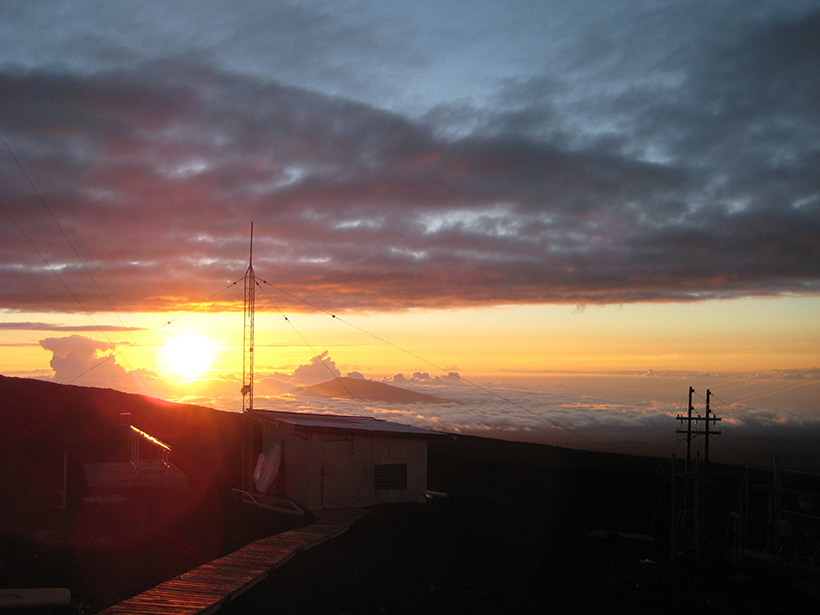This year, for the first time, atmospheric carbon dioxide (CO2) concentrations recorded at Mauna Loa, Hawaii, will exceed 400 parts per million (ppm) and remain above this level indefinitely. This sustained high level is due to El Niño effects, which disrupt carbon sinks and increase emissions from forest fires, according to findings published Monday in Nature Climate Change.
In 2015 the annual average concentration passed the 400-ppm mark, but monthly concentrations fell back to about 397.5 ppm during the summer and fall. But now there’s no going back to pre-400-ppm levels, explained lead author Richard Betts of the Met Office Hadley Centre for Climate Science and Services and the University of Exeter in the United Kingdom.
The 400-ppm mark would have been exceeded “next year or later anyway, but El Niño has caused the CO2 to rise extra fast this year,” Betts said. “We hit the mark earlier than expected.”
El Niño and Emissions
In a normal year, water in the eastern Pacific Ocean is about 8°C cooler than in the western Pacific. This is because wind patterns typically push water to the west, bringing cool, deep water to the surface of the eastern Pacific.
El Niño dramatically alters this cycle—winds get weaker, and warm water slumps into the eastern Pacific, raising ocean temperatures. The cascade of ensuing weather patterns increases drought and fire in the tropical western Pacific.
For example, the 1997 El Niño caused dry conditions in Indonesia and Malaysia, which exacerbated human-caused fires and ignited carbon-rich peatlands that burned out of control for months, contributing to an anomalously high annual atmospheric CO2 growth rate. This year, drought conditions in Indonesia, brought on by the 2015–2016 El Niño, have also spurred expansive fires.
A Threshold Crossed
Models have simulated the strength of El Niño effects and sea surface temperature, but no previous study had predicted the total contributions of El Niño effects to atmospheric CO2 levels.
The small carbon dioxide increase lasts only as long as El Niño itself, but the damage to carbon sinks from drought and fire has the additional effect of slowing carbon removal over time.
Betts and his colleagues focused on the 2015–2016 El Niño, using data collected at the historic Mauna Loa Observatory in Hawaii, where rising atmospheric CO2 was first recorded in 1958. The team built a statistical model using multiple linear regression analysis to relate sea surface temperatures and atmospheric CO2 concentrations.
According to the findings, CO2 levels will break historic records this year. The monthly mean CO2 concentration at Mauna Loa is predicted to remain above 400 ppm year-round, and the El Niño effect is estimated to contribute an additional 0.5–1.5 ppm to the usual year-by-year rise of about 2 ppm. This small increase lasts only as long as El Niño itself, perhaps with a small lag, but the damage to carbon sinks from drought and fire has the additional effect of slowing carbon removal over time.
Shifting Baselines

“All surface monitoring stations around the world have now seen baseline episodes of 400 ppm or more,” says Paul Fraser of the Cape Grim Baseline Air Pollution Station in Smithton, Tasmania, Australia. Cape Grim hit this record for the first time last month, and Fraser expects that observations will remain high.
With the exception of monitoring stations at high latitudes in the Arctic, where levels might not hit 400 ppm every month, levels around the globe are expected to exceed 400 ppm for hundreds of years, if not longer, adds Fraser, who was not affiliated with the study. Because natural sinks only remove CO2 gradually, atmospheric levels will remain high even if humans curb emissions.
“Carbon dioxide levels will still increase unless we dramatically reduce emissions,” says study coauthor Ralph Keeling of the Scripps Institution of Oceanography in San Diego, Calif. “We can cut the growth rate in atmospheric carbon dioxide concentrations, but total levels will increase unless emissions are cut by about 50%.”
—Amy Coombs, Editorial Intern; email: [email protected]
Citation:
Coombs, A. (2016), El Niño will increase atmospheric carbon to historic levels, Eos, 97, https://doi.org/10.1029/2016EO054401. Published on 16 June 2016.
Text © 2016. The authors. CC BY-NC-ND 3.0
Except where otherwise noted, images are subject to copyright. Any reuse without express permission from the copyright owner is prohibited.

